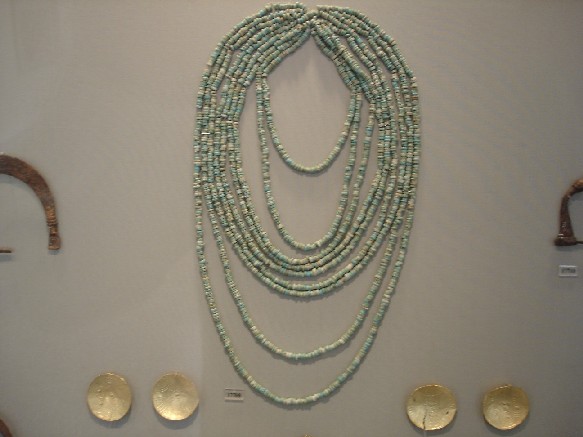-
 Necklace beads of faience
Necklace beads of faience
From the large cist grave which was discovered on Skyros in 1935. The grave offerings attest that the cist probably contained a double burial i.e. of a man , the earlier (late 11th -early 10th c. BC.) and of a woman, the later (900-850 Bc.). Most of the objects, which furnished the female inhumation, bear witness to the island's wealth and indicate that the deceasedbelonged to an important family. The location of Skyros was significant in this period, because it served as a bridge between Greece and the East.
National Archaeological Museum of Athens
-
 gold bosses
gold bosses
Ten gold bosses with empbossed decoration ,which were found on the female's chest , must have been fixed on a garment of cloth or hide. From the large cist grave on Skyros (11th c. BC.). National Archaeological Museum of Athens.
-
 Bronze bow brooche
Bronze bow brooche
From the large cist grave on Skyros (11th c. BC.). National Archaeological Museum of Athens
-
 Pin
Pin
Type of the 11th-9th BC. From Delos. National Archaeological Museum of Athens
-
 Bow
Bow
Bow fibula, of Greek Mainland type. Late 8th BC. National Archaeological Museum of Athens
-
 pin and earrings
pin and earrings
Pin . Early 7th c. BC. Earring . Type of 8th c. BC. National Archaeological Museum of Athens
-
 Diadem
Diadem
Diadem with thistle leaves. Possible from the cult statue of Artemis. 7th - 6th c. BC. National Archaeological Museum of Athens
-
 Pins
Pins
15330,15333,15334,15368,15369, 15390 Pins. Peloponnesian types. 7th c. BC. 15370,15387 Pins with globular knobs towards the top. Late 8th c. BC. National Archaeological Museum of Athens
-
 Bow fibula
Bow fibula
The type reached Greece from the north , perhaps via Italy. 12th c. BC. National Archaeological Museum of Athens
-
 Bracelet
Bracelet
9th - 8th cent. BC. National Archaeological Museum of Athens
-
 Bracelet
Bracelet
With spiral finials. The types are widely spread in the 8th and 7th c. BC. National Archaeological Museum of Athens
-
 Gold pins
Gold pins
Three gold pins. 8th-7th c.BC. National Archaeological Museum of Athens
-
 Gold necklace
Gold necklace
Gold necklace beads. 7th c. BC. National Archaeological Museum of Athens
-
 Silver pin
Silver pin
Silver pin with Peloponnesian and Cretan features . 650 BC. National Archaeological Museum of Athens
 fibula
fibula
Fibula of Attic-Boeotian type. The catch-plate bears an incised depiction of battle scenes: on one side Heracles fighting the Siamese twins, the Moliones or Aktoriones, and on the other two archers on a ship. About 700-675 BC. National Archaeological Museum of Athens Geometric period jewellery
Geometric period jewellery
From the tomb of Isis at Eleusis. Middle Geometric period (850-760 BC.). National Archaeological Museum of Athens Geometric period jewellery
Geometric period jewellery
From the tomb of Isis at Eleusis. Middle Geometric period (850-760 BC.). National Archaeological Museum of Athens Geometric period jewellery
Geometric period jewellery
From the Protogeometric cemetery at New Ionia, Attica. About 950-900 BC. National Archaeological Museum of Athens-
 Necklace beads of faience
Necklace beads of faience
From the large cist grave which was discovered on Skyros in 1935. The grave offerings attest that the cist probably contained a double burial i.e. of a man , the earlier (late 11th -early 10th c. BC.) and of a woman, the later (900-850 Bc.). Most of the objects, which furnished the female inhumation, bear witness to the island's wealth and indicate that the deceasedbelonged to an important family. The location of Skyros was significant in this period, because it served as a bridge between Greece and the East.
National Archaeological Museum of Athens
[Home
Page]
[Contact
me]
Necklace beads of faience
gold bosses
Bronze bow brooche
Pin
Bow
pin and earrings
Diadem
Pins
Bow fibula
Bracelet
Bracelet
Gold pins
Gold necklace
Silver pin
fibula
Geometric period jewellery
Geometric period jewellery
Geometric period jewellery
Necklace beads of faience